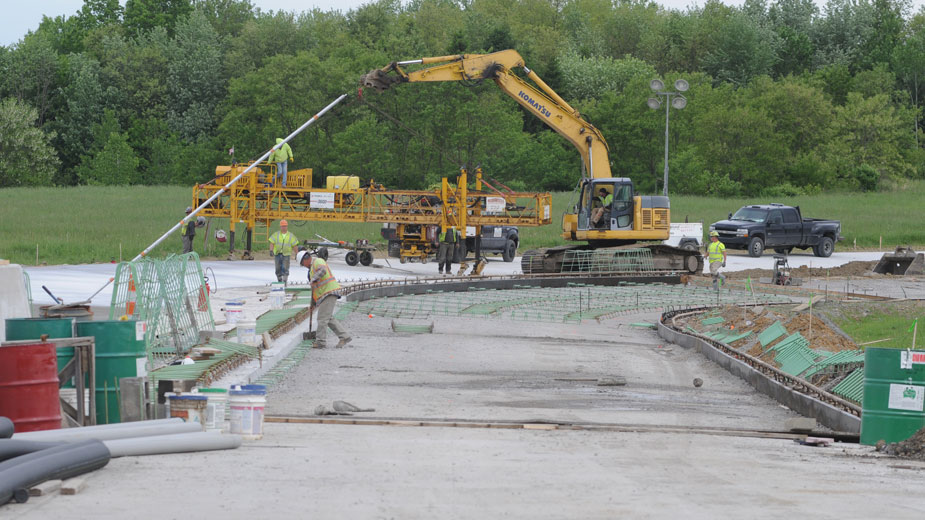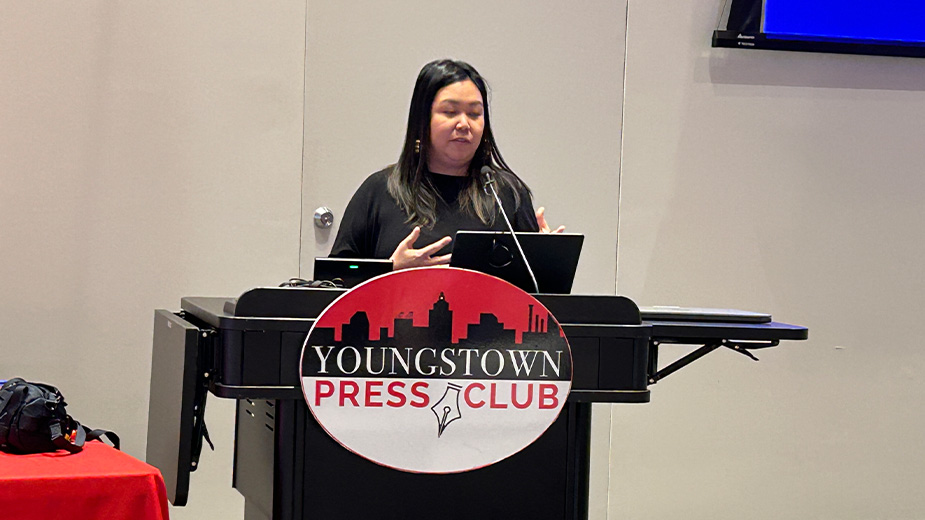Operating Engineers See No Shortage of Work
YOUNGSTOWN, Ohio – All too often adults scoff at young people glued to video games as they spend hours using handheld consoles to zap otherworldly marauders or take down virtual would-be assassins.
But let’s not be too quick to judge. The skills perfected here could be the first step in that young person’s development as an operating engineer.
“When you see something in front of the blade of that dozer, you have to maneuver those joysticks and move that bucket to wherever it needs to go,” says Tom Durkin, president of Local 66 of the International Union of Operating Engineers. “We test for hand-eye coordination and some of the apprentices today have this ability more so than those who were coming into the program 25 or 30 years ago.”
Durkin attributes this skill to a generation of youngsters who came of age playing computer and video games. “They’re pretty good at it,” he says. “So, it may have actually helped.”
Becoming an operating engineer takes much more than developing strong hand-to-eye coordination, Durkin says, but these fundamental skills are important nonetheless. “If you can’t pass a hand-eye coordination test, then the chances are pretty slim you’d be accepted into the program,” he says.
Operating engineers are the movers and haulers of the construction and building trades, Durkin says. Every day, these workers operate heavy equipment such as high-boom cranes, bulldozers, earthmovers and large backhoes that are among the first on the site of major construction projects.
Today this trade is busier than ever, Durkin says. Even more heartening is the long line of young applicants waiting to join the already bursting union apprenticeship program. “We have more individuals applying for apprenticeships than we’ve ever had,” he says. “And, we’ve never had this many trainees.”
Durkin is reluctant to speculate as to why there is so much renewed interest in the operating engineers, but it’s clear that part of the reason is the good wages and availability of work related to the oil and gas industry.
Journeymen in the trade earn between $33 and $35 per hour, Durkin says, excluding the union benefits package. Apprentices start at about $13 an hour, but are given pay raises each year during the course of the four-year program, he says.
Apprentices are trained at the union joint training center in New Alexandria, Pa., near Monroeville, Durkin says. “It’s really growing.”
More important, there’s plenty of work, he adds. The $6 billion cracker plant that Royal Dutch Shell is constructing near Monaca, Pa., and combined-cycle electrical-generation plants under development in Wellsville and in Lawrence County, Pa., as well as other local roadway and public projects, bode for a very busy season for the trade.
Operating Engineers Local 66 consists of seven districts that cover 36 counties – three in northeastern Ohio and 33 in Pennsylvania. The District 2 office in Boardman covers Mahoning, Trumbull and Columbiana counties in Ohio.
Carlton Ingram, District 2 business agent, says he expects a sizeable amount of highway and roadwork this summer to keep operating engineers in the driver’s seat.
“The thing that’s really held us up is the weather,” he says. Rain throughout most of April and May has led to delays in select projects across the Mahoning Valley. “I would imagine after Memorial Day it’s going to be full bore ahead.”
A major roundabout project at Five Points – a five-way stop at North Lima, Springfield and East Western Reserve roads in Poland Township – is underway with operating engineers on-site, Ingram says. Road-paving projects in Poland Township, plus additional work on the Ohio Turnpike at the Eastgate exit will also use operating engineers.
The entire membership of Local 66 numbers about 7,000, while District 2 boasts about 1,200 including retirees, Ingram says. Approximately 650 of that number are active, he says.
Demand is such that some of the retirees are still working, Ingram adds, as the union attracts even more young people to the trade. “In the past, we would have between 120 and 130 total in our four-year program,” Ingram says. “Right now, we have 436.”
That’s integral to the future of the local, Durkin adds, as older members retire and those positions are filled.
“I joined the operators in 1964,” Durkin reflects, when the district office was in Warren. “At the time, I ran a rubber-tired backhoe.”
Demand for skilled operating engineers began to increase during the mid-1950s when the Eisenhower Administration provided funding for a new interstate-highway system, according to Durkin. “That’s when we started to gain momentum,” he says.
The biggest push for talent arrived a decade later with the construction of the General Motors Lordstown assembly plant – among the first major projects on which Durkin worked. That work was followed several years later with the additions of the metals-stamping plant and a van production plant.
At that time, area contractors had on staff a handful of operators able to handle smaller jobs, Durkin says. The Lordstown project was so massive that the need for additional skilled operators soared – kicking off a good decade of substantial work for Local 66.
While there was always work in the steel industry – operating engineers were instrumental, for example, in furnace relining projects or heavy maintenance efforts – these jobs would average just several months at a time, Durkin says. Plus, they were usually less intensive than the task of constructing a 6-million-square-foot manufacturing plant such as Lordstown from the ground up.
This demand didn’t hold, Durkin laments. By the late 1970s and early 1980s, construction activity started to wane in the region, compromised by the closing of major steel mills such as the Youngstown Sheet & Tube Campbell and Brier Hill operations and the Ohio and McDonald Works of U.S. Steel.
Work for the operating engineers remained sporadic and cyclical for the next two decades, Durkin says. Then, in the early 2000s, tradesmen in western Pennsylvania started to pick up work related to companies exploring natural gas and oil deposits trapped in the Marcellus shale, especially in the southwestern portion of the state.
By 2007, the region was crawling with bright yellow machinery as operators prepared sites for new cryogenic plants, pipelines, drilling pads and processors. “That’s what really restarted work for us,” Durkin says.
By 2011, oil and gas exploration had moved into Ohio as energy companies canvassed the state, drilling in the Utica/Point Pleasant shale formation. As this part of the Appalachian basin developed, it attracted end-users such as natural-gas-fueled electrical-generation plants and a Shell cracker plant.
Operating engineers are currently on-site near Wellsville in Columbiana County preparing ground for South Field Energy’s $1.3 billion electrical plant. Local 66 is also helping to construct the Hickory Run Energy Station, an $863 million combined-cycle electrical plant in North Beaver Township, Pa. owned by Tyr Energy, a subsidiary of Japanese energy giant Itochu.
Earlier this year, operations began at the Lordstown Energy Center, a $900 million energy-generation plant that required nearly 1,000 tradesmen to build, including operating engineers from Local 66. Development of a second energy-generation plant at the site on Henn Parkway in Lordstown is in its development stage and would require the same amount of manpower over two years.
The most significant project is the Shell ethane cracker plant near Monaca, Pa., Durkin says. “This is an extremely large facility in great need of building tradesmen throughout the entire region.”
When finished, the plant would convert ethane gas from the Utica and Marcellus shales into polyethylene pellets, which are used in plastics and other materials.
The work is hard, Durkin notes, adding that operating engineers are putting in 10-hour days, six days a week. After contractors suggested they go to 11-hour days, some of the workers balked because they felt close to burnout.
“There were a tremendous amount of hours available to work – and the paychecks are big,” he says.
Officials say the cracker plant should be finished by 2022, so there is plenty of opportunity for operating engineers over the next two years. At peak construction, about 6,000 managers, engineers and tradesmen representing all the crafts should be on-site. “There are an awful lot from Youngstown working down there,” Durkin says.
While the high-profile projects consume most of the attention, the operating engineers are important to contractors in that they are a wellspring of qualified, skilled tradesmen and have been so for decades.
As you walk into the lobby of the District 2 office on McClurg Road in Boardman, you’re greeted with a display case that holds memorabilia from union members who cut their teeth during World War II in the Army Corps of Engineers, old union cards and buttons that feature the many contractors and companies that once did business here.
Companies such as the William B. Pollock Co., the Packard Electric Construction Division and the Pittsburgh Coke & Chemical Co. Struthers Division have all disappeared.
Others such as A.P. O’Horo Co. and Diamond Steel Construction Co. have proven resilient and still do business with the operating engineers today.
“What we rely on the operating engineers for is to provide qualified, competent crane operators,” says Dave Collins, president of Diamond Steel in North Lima. “They’ve got a great crane-certification program that helps us and other signatory contractors.”
Diamond Steel specializes in steel erection and heavy lifting operations. The company’s fleet includes more than 20 cranes capable of lifting between six and 150 tons.
Collins says his company has used the operating engineers for big crane jobs such as hoisting heavy HVAC units onto rooftops, steel erection projects such as the tower at St. Charles Church and recently the flagpole at Kufleitner’s Chrysler Jeep Dodge dealership in Boardman. “There’s never been a job where we used a whole lot of them – maybe two or three at a time,” Collins says.
Business this year doesn’t quite match up to last year’s busy season, but work has been steady for the company, Collins says.
Still, the quality of a project reflects the reputation of the contractor, and Collins says he could always depend on the operating engineers to provide the best. “A large percentage of the success of the job depends on the skill of the crane operator,” he says. “They’ve done a wonderful job.”
Pictured: Operating engineers work on the roundabout at Five Points on Western Reserve Road in Mahoning County.
Copyright 2024 The Business Journal, Youngstown, Ohio.



